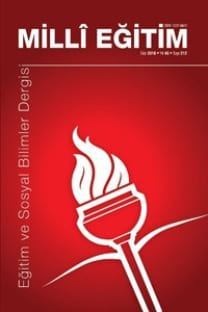MADDENİN TANECİKLİ YAPISI İLE İLGİLİ İKİ AŞAMALI TANILAYICI SORULARIN ONTOLOJİ TEMELİNDE GELİŞTİRİLMESİ
Maddenin tanecikli yapısı konusunda, ontolojik kategorilerin kuramsalçerçeve olarak kullanıldığı, iki aşamalı soruların geliştirilmesi bu çalışmanınamacını oluşturmuştur. Araştırmanın odağında özellikle, 1) soruların geliştirilmesi sürecinde yapılan pilot uygulamada öğrencilerden dönüt alma, 2)dönütlerde görülen, konu ile ilgili öğrenci düşünce biçimlerini anlama, 3)kavram yanılgılarının ontolojik temelini tanılama, yer almıştır. Ortaöğretim dersprogramıyla bağlantılı olarak 15 tane iki aşamalı tanılayıcı soru hazırlanmıştır.Kapsam geçerliliğini sağlamak için uzman görüşlerine göre test maddelerindedüzeltmeler yapılmıştır. Soruları güçlendirmek ve elde edilecek sonuçlarıngeçerliliğini sağlamak amacıyla öğrenci dönütlerini almak üzere 2007-2008 öğretim yılının ikinci döneminde, İstanbul’da bir ilköğretim okulu ve bir dershanedebulunan toplam 178 öğrenciyle soruların pilot uygulaması yapılmıştır. Pilotuygulamada öğrencilere her bir soruyla ilgili 14 dönüt sorusu sorulmuştur. Pilotuygulamadan sonra öğrencilerden alınan dönütlere göre sorular düzeltilmiş veiyileştirilmiştir. Anlamlı öğrenme için iki aşamalı tanılayıcı sorular kadar busoruların kapsam geçerliliğinin etkin bir biçimde sağlandığı geliştirme süreci de önemlidir
DEVELOPMENT OF TWO TIER DIAGNOSTIC ITEMS BASED ON ONTOLOGY IN THE TOPIC OF THE PARTICULATE NATURE OF MATTER
The purpose of this study was to develop an instrument assessing student understanding on the particulate nature of matter by utilizing ontological categories as theoretical lens. We particularly focused on: 1) portraying the ontological basis of related misconceptions 2) the way student feedback during pilot testing aided item development, 3) student thinking as revealed through their provided feedback. Aligned with content in the middle school curricula, an assessment instrument of 15 distractor-driven, multiple-choice, two-tier items were constructed. Then, revisions were made to the items according to expert suggestions, ensuring content validity. Subsequent to content validity work, to utilize student feedback for the improvement of the items and the validity of the inferences, we pilot tested our instrument in the second semester of 2007-2008 with 178 students attending a middle school and a private tutoring center in İstanbul. In the pilot test, the students were asked 14 questions about each item. After the pilot testing, most of the items were revised and improved according to the students’ feedback. In this article we discuss the development process and exemplify the revisions made according to student feedback and results from the pilot testing.
